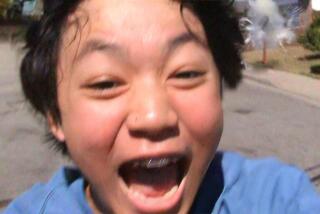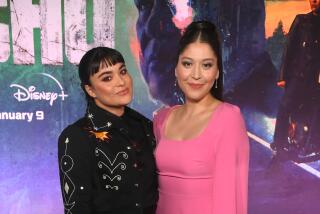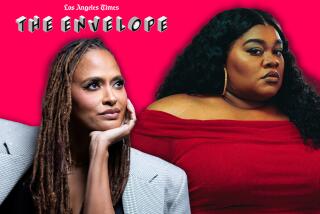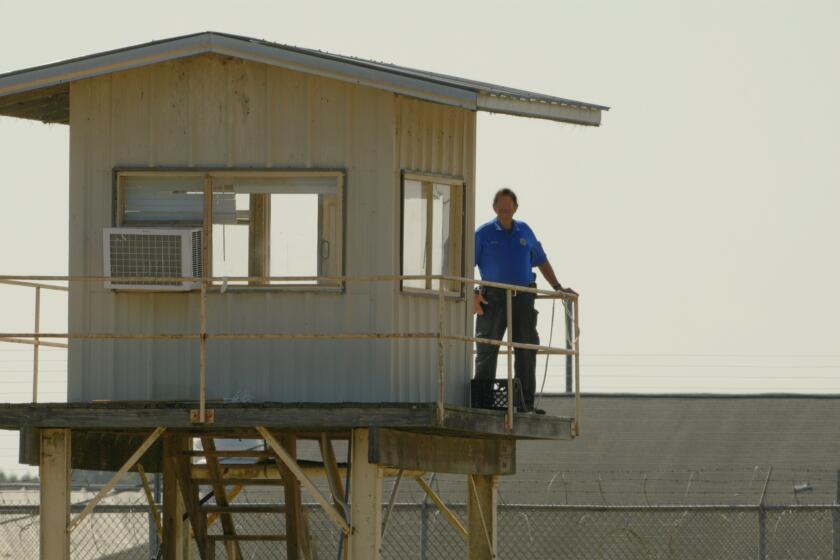Review: Gugu Mbatha-Raw rises above an overstuffed script in ‘Belle’
- Share via
In a strange sense, “Belle,” dressed up in the corsets and social conventions of Georgian England, proves a good canvas for its mannered conversation about race.
In an even stranger sense, the way the film examines and exposes the attitudes of London’s not-so-polite society echoes the current conversation about race swirling around the charged comments of Los Angeles Clippers owner Donald Sterling.
Which makes “Belle’s” shortfalls all the more disappointing.
The historical drama, starring Gugu Mbatha-Raw as the mixed-race beauty at its core, is inspired by a 1779 painting thought to be the work of a well-known British portraitist. It shows two young women as compatriots; you might think them sisters but for the fact that one is black, the other white. Their equality on the canvas is more striking than their beauty.
With that and other details drawn from what little is known of Dido Elizabeth Belle (Mbatha-Raw), director Amma Asante and screenwriter Misan Sagay spin a provocative fiction out of her life. “Belle” has a great deal of conviction and is cut from the same emotional cloth as the groundbreaking “12 Years a Slave.” What it lacks is the coherence and intensity of last year’s Oscar winner. It does, however, showcase Mbatha-Raw’s considerable talent and should secure the rising British actress a spot on Hollywood’s radar as “12 Years” did for Lupita Nyong’o.
The film zeroes in on Dido as she makes her society debut in London while her guardian and great uncle, Lord Mansfield (Tom Wilkinson), England’s chief justice, weighs a landmark case about slavery. The interplay between family ties, race relations, marriage proposals, legal issues and social slights spend a good deal of time fighting for attention, and leaves the film fighting for its identity.
The stage for the friction is set when Dido’s father (Matthew Goode), an admiral in the Royal Navy, asks his aunt and uncle, Lord and Lady Mansfield (Emily Watson), to raise his illegitimate daughter (Lauren Julien-Box as young Dido). The childless couple is already caring for another niece, Elizabeth (Cara Jenkins as the child / Sarah Gadon the adult), and the girls are soon inseparable.
But the specter of race is never far. When other families call on the Mansfields’ country estate, for example, Dido is served her meals separately, though she is allowed to join the group in the parlor after. That dichotomy frames the film and colors every scene. As “Belle” underscores, for all of Dido’s advantages, including the money she inherits from her father ensuring a comfortable life, discrimination cloaked in civility still leaves scars.
Despite the racial divide of the day, Dido’s fortune means she is courted by under-funded noblemen. Director of photography Ben Smithard, production designer Simon Bowles and costume designer Anushia Nieradzik create a lovely muted look for the costume drama that nicely echoes the society’s repressed resistance to having Dido in their midst.
Lady Ashford, a tart Miranda Richardson forever looking as if she’s bitten a lemon, has two sons, a fading fortune and rising ambitions. Lord Mansfield’s nieces seem a good solution — Elizabeth, a suitable match for older son James (Tom Felton), and Dido acceptable for Oliver (James Norton). The vicar’s son, John Davinier (Sam Reid), a fiery civil rights activist attracted to Dido, complicates matters.
Meanwhile, the infamous Zong trial is kicking up controversy. A slave ship that dumped its cargo, i.e. its slaves, in the ocean is pressing the insurer to cover its losses. Despite the clear moral imperatives, the legal arguments are complex and the debate rages raggedly from the courthouse to the Mansfields’ home.
“Belle” is the second film for British actress-turned-director Asante, who made her writing/directing debut with 2004’s “A Way of Life.” She has a nice touch with the actors, but cannot hold the film together around the story. Sagay, probably best known for adapting “Their Eyes Were Watching God,” the 2005 ABC TV movie that starred Halle Berry, has so much she wants to say about race and class, too much.
It leaves the movie torn between the slavery debate and Dido and Davinier’s love story. Though the terrific chemistry between Mbatha-Raw and Reid helps, the courtship itself increasingly feels like the fiction it is — the couple strolling crowded London streets discussing the merits of the Zong ship trial, Dido cracking the case and slipping Davinier the documents he needs to make the argument.
The talented Mr. Wilkinson treads the rocky road he’s given with a nuanced ease. His scenes with Mbatha-Raw — as a man caught between love for his niece and his loyalty to the rule of law — are among the film’s best.
“Belle” is greatly buoyed by Mbatha-Raw’s performance. She infuses Dido with a confident and intelligent grace that keeps you engaged long after the tangled story has let both the actress and audience down.
More to Read
Only good movies
Get the Indie Focus newsletter, Mark Olsen's weekly guide to the world of cinema.
You may occasionally receive promotional content from the Los Angeles Times.











